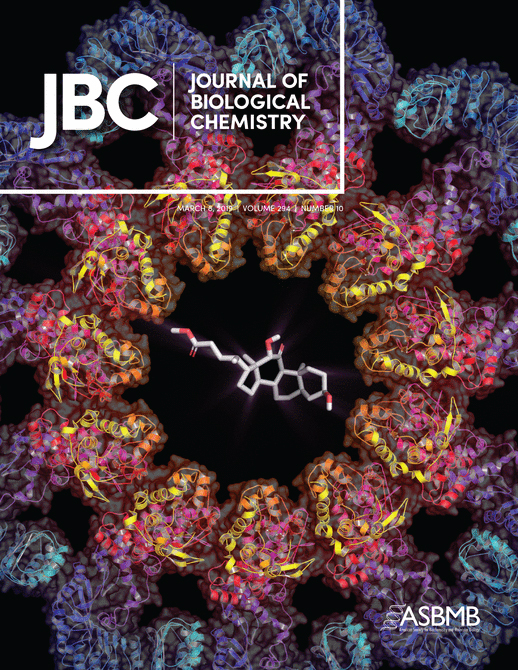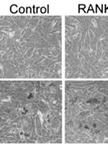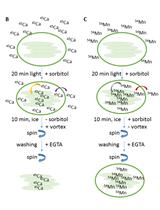- EN - English
- CN - 中文
Quantitative Determination of Ca2+-binding to Ca2+-sensor Proteins by Isothermal Titration Calorimetry
钙离子与钙离子传感器蛋白结合的等温滴定量热法定量测定
发布: 2020年04月05日第10卷第7期 DOI: 10.21769/BioProtoc.3580 浏览次数: 5509
评审: Geoffrey C. Y. LauAndrew L. EagleAnonymous reviewer(s)
Abstract
Diverse and complex molecular recognitions are central elements of signal transduction cascades. The strength and nature of these interaction modes can be determined by different experimental approaches. Among those, Isothermal titration calorimetry (ITC) offers certain advantages by providing binding constants and thermodynamic parameters from titration series without a need to label or immobilize one or more interaction partners. Furthermore, second messenger homeostasis involving Ca2+-ions requires in particular knowledge about stoichiometries and affinities of Ca2+-binding to Ca2+-sensor proteins or Ca2+-dependent regulators, which can be obtained by employing ITC. We used ITC to measure these parameters for a set of neuronal Ca2+-sensor proteins operating in photoreceptor cells. Here, we present a step wise protocol to (a) measure Ca2+ interaction with the Ca2+-sensor guanylate cyclase-activating protein 1, (b) to design an ITC experiment and prepare samples, (c) to remove Ca2+ nearly completely from Ca2+ binding proteins without using a chelating agent like EGTA.
Background
Isothermal titration calorimetry (ITC) is a label free method to investigate bio-molecular interaction processes by measuring heat release or heat consumption during a binding process. These processes could occur between different forms of molecules including macromolecules and/or small ligands. The principle design of the measuring device consists of two cells (a reference and sample cell) in an adiabatic jacket. One binding partner is present in the sample cell, while the other interacting molecule is injected into the sample cell. The reference cell contains a buffer solution of water. Temperature differences between sample cell and reference cell are sensed by detectors and an equal temperature between both cells is maintained by a combination of a heater system and a feedback circuit. Interaction of two molecule species either releases or consumes heat, which is detected based on the heater/feedback system. ITC can be applied for example to study a wide range of interaction processes including protein-protein (Pierce et al., 1999), protein-carbohydrate, protein-DNA, enzyme-substrate and cation-protein (Wiseman et al., 1989; García-Hernández et al., 2003; Kozlov and Lohmann, 2012; Mazzei et al., 2014). Alternative methods like surface plasmon resonance (SPR), back scattering interferometry or fluorescence-based techniques utilize different principles and each technique has its own advantages and disadvantages. SPR requires immobilization of one binding partner and fluorescence would in most cases need site-specific labelling. ITC is a method of choice to measure direct ion binding to proteins for deriving binding constants. Furthermore, ligand binding or protein-protein interactions can be studied without the need to label or immobilize one binding partner and has also shown promises in drug discovery science (Ward and Holdgate, 2001; Weber and Salemme, 2003; Lim et al., 2009; Sulmann et al., 2015). The values extracted from ITC measurements are the binding constants (Ka), binding stoichiometry (n), free energy (ΔG), enthalpy (ΔH) and entropy (ΔS). In another words, it provides thermodynamic parameters in addition to binding constants. Since Ca2+ ions play important roles in intracellular signaling, it’s important to understand the intracellular detection of Ca2+ by Ca2+-sensor proteins and to investigate the interaction processes in quantitative terms. Among Ca2+-sensors, one subgroup of neuronal Ca2+-sensor (NCS) proteins is important for the primary processes of vision in photoreceptor cells, where they are involved in Ca2+-feedback mechanisms to control deactivation processes and sensitivity of photoreceptor cells to light. Guanylate cyclase-activating proteins (GCAPs) are NCS proteins that regulate the activity of membrane bound guanylate cyclases in a Ca2+-dependent manner, thereby controlling the cytoplasmic concentration of cyclic GMP, the second messenger of photoexcitation in photorecepotor cells. Several point mutations in GCAP1 lead to severely impaired vision or blindness and amino acid substitutions in different positions appear to cause some common features (Marino et al., 2015; Vocke et al., 2017; Marino et al., 2018; Peshenko et al., 2019). For example, mutant GCAP1 proteins undergo different conformational changes due to impaired Ca2+-binding, and it often results in constitutive activity of the GCAP1/guanylate cyclase complex. Eventually it causes an imbalance of the Ca2+/cyclic GMP homeostasis. ITC has been applied for measuring the binding of Ca2+ and Mg2+ to GCAPs (Lim et al., 2009; Sulmann et al., 2015; Peshenko et al., 2019), but also to recoverin (Dell'Orco et al., 2010; Abbas et al., 2019), calmodulin (Beccia et al., 2015) visinin-like protein 3 (Li et al., 2016) neuronal calcium sensor 1 (NCS-1) (Tsvetkov et al., 2018) and other Ca2+ sensor proteins. An alternative method specifically developed for measuring Ca2+-protein bindings is the Chelator assay, which utilizes the presence of a detectable and titrable Ca2+-chelator (e.g., BAPTA). It measures the binding between the protein of interest and free Ca2+ (Linse, 2002). Both techniques are to some degree complementary and have been used in combination in a recent publication (Elbers et al., 2018).
In this protocol, we provide a step-by-step description for using ITC in Ca2+- and Mg2+-binding studies. Since Ca2+-sensor proteins can contain sometimes binding sites of very high affinity, it is a challenging task to remove bound Ca2+-ions nearly completely from the protein. Therefore, we also provide a protocol to decalcify Ca2+-sensor proteins without using a chelating substance like EGTA. This protein decalcification protocol can be used for preparing Ca2+-binding proteins used in other techniques (surface plasmon resonance, backscattering interferometry, and Chelator assay). In general, the protocol defines the essentials to design an ITC experiment and analysis of ITC data.
Materials and Reagents
- Pipette tips 10 µl (Sartorius)
- Pipette tips 200 µl (Sartorius)
- Pipette tips 1,000 µl (Sartorius)
- Pipette set (SARSTEDT, Nümbrecht)
- Standard Falcon tubes 15 ml (DARSTEDT AG & CO.KG, catalog number: 9042012)
- Standard Falcon tubes 50 ml (DARSTEDT AG & CO.KG, catalog number: 9042211)
- Polypyro 0.2 µm membrane filters (Pall Corporations, catalog number: 32771646)
- Dialysis membrane (SERVA, dialysis tubing, MWCO 12,000-14,000 RC, diameter 21 mm catalog number: 44144.02)
- Ultracentrifuge tubes, 30 ml (G-Kisker GbR product, UZ-PC-38.5-2)
- Photometer cuvettes (Semi-micro Q-VETTES, 1.6 ml PS, Ratiolabs, catalog number: 2712120 )
- Disposable vinyl gloves (Semper guard)
- Plastic bottle, 100-500 ml, local supplier
- Omnifix® Solo, B.Braun 5 ml syringe
- PD10 column (GE Healthcare, catalog number: 28925232A); 2-3 used ones
- Ethanol (Sigma-Aldrich, catalog number: STBJ2652)
- Sodium dodecyl sulfate (SDS)
- HEPES (Roth, catalog number: 9105.2 )
- EGTA (Roth, catalog number: 3054.3)
- KCl (Apllicem, catalog number: 7447.40.7)
- NaCl (Sigma-Aldrich, catalog number: STB117768)
- NaOH (Fisher Scientific, catalog number: 1310.732)
- Dithiothreitol (DTT)
- Tris or trisaminomethane (Acros Organics, catalog number: A0394024)
- Chelex material (Chelex 100® sodium from Sigma-Aldrich)
- Guanidine HCl (Roth, catalog number: 6069.3)
- LB medium (Roth, catalog number: X964.4 )
- Ampicillin (Roth, catalog number: K029.2 ), store at 4 °C
- Kanamycin (Omnilife science) store at 4 °C.
- Ammonium sulphate (Roth, catalog number: 3746.1 )
- Bradford reagent (Bio-Rad, catalog number: 500-00069, store at 4 °C.
- Myristic acid (Fluka, catalog number: BCBJ9925L), store at 4 °C.
- BAPTA (1,2 Bis (2-aminophnoxy) ethane-N,N,N’,N’-tetra acetic acid tetra sodium salt) from Sigma-Aldrich
- Calcium standard solution, 10 g/L (WTW D-82362 Weilheim; https://www.fishersci.de/shop/products/es-ca-model-standard-solution/10099770)
- Urea (Roth, catalog number: X999.3 )
- Kimmwipes® lite (Kimberly-clark)
- Methanol (Sigma-Aldrich, catalog number: STBH6784)
- Decon 90 (ITC system cleaning detergent) (Decon Laboratories Limited)
- Anion exchange chromatography buffer A (see Recipes)
- Anion exchange chromatography buffer B (see Recipes)
- Size exclusion chromatography buffer (see Recipes)
- ITC buffer (see Recipes)
Equipment
- Size exclusion chromatography column (Hiload 26/60 superdex 75, GE, catalog number: 17-1070-01)
- Anion exchange chromatography column (Hiload 26/10 Q sepharose High performance, GE, catalog number: 17-1066-09)
- Glass beaker (100-200 ml, Schott Duran)
- Water bath (Memmert)
- -80 °C freezer (Thermos Electron Corporation)
- Vortex (Vortex Genie2)
- Centrifuge (Backman Coulter, Avanti J-E centrifuge, Rotor: 70Ti)
- Ultracentrifuge (Kendro Laboratory product, Rotor: AT4)
- Ultracentrifuge (SORVALL Discovery M120SE, Rotor: JA 25.50)
- Photometer (Food ALYT OMNILAB, 122197)
- UV-Vis spectrophotometer (UV-Vis SpecORD 205, 5BU1768)
- Äkta start protein purification system (GE Healthcare Life Science, catalog number: 29003181)
- Solvent filtration device (Nalgene)
- Degasser (thermoVac microcal)
- Isothermal titration calorimetry system (VP-ITC microcalorimetry, Microcal)
Software
- Origin®, Microcal, Northampton, MA https://www.malvernpanalytical.com/en
- WinASPECT spectroanalytical software https://www.analytik-jena.de/
Procedure
文章信息
版权信息
© 2020 The Authors; exclusive licensee Bio-protocol LLC.
如何引用
Readers should cite both the Bio-protocol article and the original research article where this protocol was used:
- Abbas, S. and Koch, K. W. (2020). Quantitative Determination of Ca2+-binding to Ca2+-sensor Proteins by Isothermal Titration Calorimetry. Bio-protocol 10(7): e3580. DOI: 10.21769/BioProtoc.3580.
- Peshenko, I. V., Cideciyan, A. V., Sumaroka, A., Olshevskaya, E. V., Scholten, A., Abbas, S., Koch, K. W., Jacobson, S. G. and Dizhoor, A. M. (2019). A G86R mutation in the calcium-sensor protein GCAP1 alters regulation of retinal guanylyl cyclase and causes dominant cone-rod degeneration. J Biol Chem 294(10): 3476-3488.
分类
生物化学 > 其它化合物 > 离子
生物化学 > 蛋白质 > 定量
您对这篇实验方法有问题吗?
在此处发布您的问题,我们将邀请本文作者来回答。同时,我们会将您的问题发布到Bio-protocol Exchange,以便寻求社区成员的帮助。
提问指南
+ 问题描述
写下详细的问题描述,包括所有有助于他人回答您问题的信息(例如实验过程、条件和相关图像等)。
Share
Bluesky
X
Copy link













